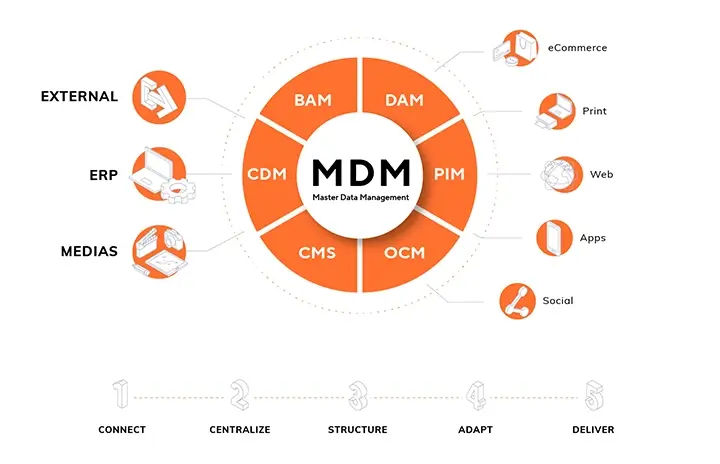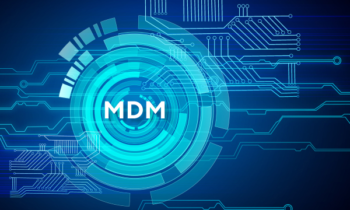MDM, PIM, DAM… Who does what?

Today, industry experts agree that we are at the peak of the data era. But even with some knowledge, understanding this complex ecosystem of information can be challenging! Especially when various IT solutions coexist, creating confusion… You know the feeling, right? And while the data flowing through a company is often referred to as the new black gold, managing it to maximize its potential benefits is no easy task.
MDM, PIM, DAM, CMS… These acronyms pop up everywhere when discussing enterprise data management. But it’s easy to get lost in the terminology. So, when it comes to Master Data Management (MDM), Product Information Management (PIM), and Digital Asset Management (DAM)… Who does what, and what problems do they solve?
MDM: Your ally to break down data silos
What is Master Data Management (MDM)?
Master Data Management (MDM) is a data management system that consolidates all the essential marketing data needed for your business operations. It defines, stores, and distributes reference data at the core of the company. Historically, DAM (Digital Asset Management) and PIM (Product Information Management) were the go-to tools for managing this information. However, MDM eliminates silos by managing, correcting, and sharing data through a single, unified database.
An MDM system connects, organizes, and distributes data from all departments, providing a 360° view of your information. It ensures that data is up-to-date, unique, and free of duplicates.
Why use Master Data Management (MDM)?
Implementing an MDM system allows you to eliminate multiple information silos and centralize them into a single source of truth. By optimizing your data processes, you improve internal task efficiency and enhance collaboration across departments. You can also streamline and automate data handling, leading to better customer experiences and reduced compliance risks (e.g., GDPR).
Who needs Master Data Management (MDM)?
While large organizations may justify using separate tools and managing data in silos, mid-sized businesses (SMEs) and intermediate-sized enterprises (ETIs) benefit greatly from data centralization. MDM aggregates data from DAM and PIM systems and enriches it with additional information, such as customer details, logistics, or technical specifications.
MDM provides a competitive advantage by simplifying business processes and allowing companies to focus on performance improvements.
What data does Master Data Management (MDM) manage?
MDM systems handle all reference data within a company, including:
- Customer data
- Product information
- Supplier details
- Employee records
- Organizational data
- Site locations
Although MDM encompasses both PIM and DAM data, it goes further by managing all business-critical data needed for marketing production and distribution. From product descriptions and images to logistics and technical information, MDM systems help businesses govern their data efficiently.
In a world driven by Martech (Marketing Technologies), MDM represents the future of data management for companies looking to simplify, centralize, and optimize their data governance processes.
PIM: Managing your product information
What is Product Information Management (PIM)?
PIM, short for Product Information Management, is a system that manages and distributes product-related information across sales channels like e-commerce websites, printed catalogs, and marketing platforms. PIM ensures that your product data is up-to-date and optimized for SEO.
In simple terms, PIM centralizes and standardizes all product descriptions and related data — references, translations, technical specs, images, dimensions, etc. Once validated, this information feeds directly into your various distribution channels.
Why use Product Information Management (PIM)?
Success in business often depends on how quickly a company can respond to market changes. This means your team must handle large amounts of product data across multiple sales channels. The key to success is ensuring data quality and consistency across the board.
By centralizing product information, a PIM system eliminates the need for time-consuming Excel spreadsheets that risk damaging your data. A well-optimized PIM helps companies improve product visibility, reduce time-to-market, and cut costs.
Who needs Product Information Management (PIM)?
Whether you’re a marketer, IT manager, e-commerce director, or buyer, PIM is essential if you need consistent product data across all channels and want to strengthen relationships with suppliers and customers.
Accurate product data displayed on an e-commerce website or catalog leads to increased sales and customer satisfaction. In short, PIM benefits any business handling product data, from retailers to B2B and B2C companies, as well as those focusing on exports.
PIM systems are accessible to all employees within the company, regardless of department, and help boost overall business performance.
What data does Product Information Management (PIM) handle?
PIM systems manage a variety of data types, including:
- Marketing data (product descriptions, translations)
- Media files (images, videos)
- Technical data (dimensions, weights)
- Design files
- User-generated content
E-commerce has increased the complexity of product data requirements, including rich content such as videos, high-quality images, and detailed specifications. Additionally, the rise of marketplaces has further diversified the types of data businesses need to manage.
With the shift from printed catalogs to digital sales channels, companies must adapt to new challenges. A PIM solution ensures that businesses can manage product data effectively and improve customer experience across channels.

DAM: Keeping your digital assets secure
What is a DAM?
Digital Asset Management (DAM) refers to the management and storage of a company’s digital assets. The term, derived from the banking sector (where asset management is a core concept), was adopted when businesses began navigating their digital transformation. In essence, DAM systems are designed to centralize and store all your digital content — photos, videos, music, presentations, projects, and more — in one secure location.
This solution not only enhances security compared to local storage but also reduces the risk of data loss or theft.
Why use a DAM?
DAM systems are particularly useful for organizing digital assets and reducing the time employees spend searching for files such as images, videos, audio files, logos, PDFs, etc. Teams from various departments — marketing, design, and others — benefit from advanced search features that allow content to be classified and organized based on keywords, formats, or content type.
Additionally, sharing and distributing assets across websites or social media channels becomes significantly easier. As the number of digital channels increases, so does the demand for visual content, leading to exponential growth in the number of files companies need to produce. With powerful features like metadata management, tagging, and dynamic search capabilities, DAM systems have become essential tools for companies looking to streamline their content workflows and improve productivity.
Who needs a DAM?
DAM systems are ideal for companies that create, share, and distribute large amounts of content. This includes advertising agencies, communication firms, and marketing departments — but, in reality, most businesses can benefit from having a DAM solution in place.
What data does a DAM manage?
The concept is straightforward: a DAM system manages all the digital files and resources used by a company, including:
- Photos
- Videos
- Audio files
- Text files
- Presentations
In other words, a DAM system helps businesses store, search, enrich, organize, and distribute thousands of digital assets efficiently and securely.
Need help defining your project? Contact our experts!


